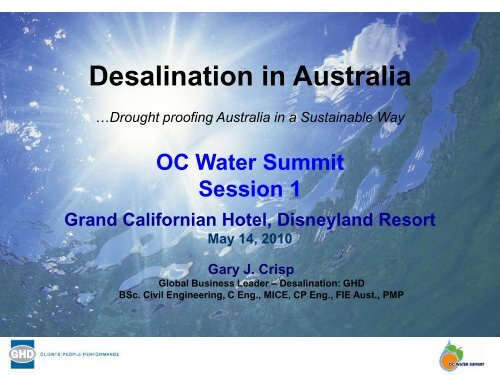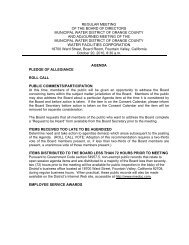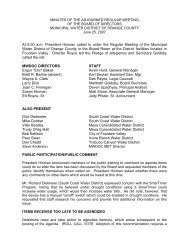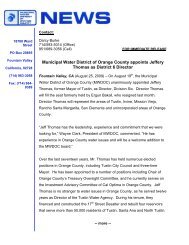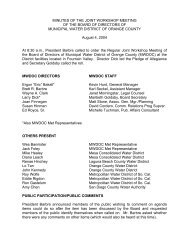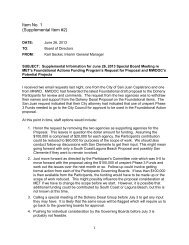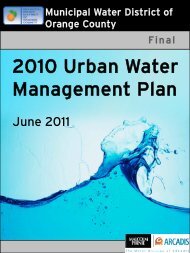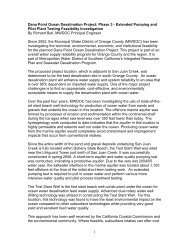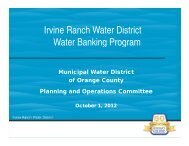Desalination in Australia
Desalination in Australia
Desalination in Australia
You also want an ePaper? Increase the reach of your titles
YUMPU automatically turns print PDFs into web optimized ePapers that Google loves.
<strong>Desal<strong>in</strong>ation</strong> <strong>in</strong> <strong>Australia</strong><br />
…Drought proof<strong>in</strong>g <strong>Australia</strong> <strong>in</strong> a Susta<strong>in</strong>able Way<br />
OC Water Summit<br />
Session 1<br />
Grand Californian Hotel, Disneyland Resort<br />
May 14, 2010<br />
Gary J. Crisp<br />
Global Bus<strong>in</strong>ess Leader – <strong>Desal<strong>in</strong>ation</strong>: GHD<br />
BSc. Civil Eng<strong>in</strong>eer<strong>in</strong>g, C Eng., MICE, CP Eng., FIE Aust., PMP
It’s not about water.<br />
It’s aboutenergy!
“Energy is eternal delight!”<br />
Energy is liberation.<br />
William Blake, author, poet, visionary, 1757 – 1827
Presentation Overview<br />
• Introduction<br />
• The Big Six, Includ<strong>in</strong>g Gold Coast
Total Annual* Inflow to Perth Dams** (GL)<br />
1911<br />
1913<br />
1915<br />
1917<br />
1919<br />
1921<br />
1923<br />
1925<br />
1927<br />
1929<br />
1931<br />
1933<br />
1935<br />
1937<br />
1939<br />
1941<br />
1943<br />
1945<br />
1947<br />
1949<br />
1951<br />
1953<br />
1955<br />
1957<br />
1959<br />
1961<br />
1963<br />
1965<br />
1967<br />
1969<br />
1971<br />
1973<br />
1975<br />
1977<br />
1979<br />
1981<br />
1983<br />
1985<br />
1987<br />
1989<br />
1991<br />
1993<br />
1995<br />
1997<br />
1999<br />
2001<br />
2003<br />
2005<br />
Impact of Dry<strong>in</strong>g Climate<br />
- Reduced Inflow to Dams (as at 1 Nov 06)<br />
1000<br />
900<br />
800<br />
700<br />
Annual Total<br />
1911-1974 av (338 GL)<br />
1975 - 1996 av (177 GL)<br />
1997 -2005 av (114 GL)<br />
Regression 1960 to 2005<br />
600<br />
500<br />
400<br />
300<br />
200<br />
2006<br />
100<br />
0<br />
Notes:<br />
- A year is taken as May to April<br />
- 2005/06 <strong>in</strong>flow to 1st November 2006<br />
Courtesy of the Water Corporation
41000 gallons/y per<br />
capita<br />
by 2012 (for Perth)<br />
Wungong Trial<br />
Gnangara P<strong>in</strong>es<br />
Metro Catchments<br />
Catchment Management<br />
Smarter use of Water<br />
Well<strong>in</strong>gton Dam<br />
Brunswick River<br />
Dam<br />
Perth Seawater<br />
<strong>Desal<strong>in</strong>ation</strong> Plant<br />
Surface Water<br />
Groundwater<br />
SW Yarragadee<br />
G<strong>in</strong>g<strong>in</strong><br />
Yanchep<br />
Egl<strong>in</strong>gton<br />
Water Efficiency<br />
From Irrigation<br />
Water Trad<strong>in</strong>g<br />
Water Recycl<strong>in</strong>g<br />
Groundwater<br />
Kw<strong>in</strong>ana Water<br />
Reclamation Plant<br />
20% reuse by 2012 target<br />
Courtesy of Water Corporation
<strong>Desal<strong>in</strong>ation</strong> History<br />
• Aristotle described distillation - 400 BC<br />
• Distillation: <strong>Desal<strong>in</strong>ation</strong> on early ships - 200AD<br />
• Distillation: MED (Norbert Rillieux, 1806 - 1894)<br />
• Coolgardie Water Distillery (WA) - 1895<br />
• Distillation: <strong>Desal<strong>in</strong>ation</strong> MSF - 1956<br />
• Distillation: <strong>Desal<strong>in</strong>ation</strong> MED - 1960<br />
• Distillation: <strong>Desal<strong>in</strong>ation</strong> MVC, METC – 1960<br />
• Membrane: RO (Drs. Sourirajan & Loeb @ UCLA, 1959)<br />
• Membrane: RO (John Cadotte - FilmTec, 1970)<br />
• Membrane: <strong>Desal<strong>in</strong>ation</strong> RO and NF - 1970<br />
• Membrane: Pre-treatment (MF, UF) - 1990<br />
• Membrane: Wastewater (MBR) - 2000<br />
Dr. Sid Loeb<br />
2005 - 2008
SWRO Power Consumption (July 1, 2001)<br />
•
Water Resource Cost Trends: US $/m 3<br />
Perth Seawater <strong>Desal<strong>in</strong>ation</strong> Plant Water Cost 0.90 $/m 3<br />
Cost ($/m 3 )<br />
THE TRIPLE BOTTOM LINE<br />
The TRUE Value of Water<br />
Obta<strong>in</strong>ed with M<strong>in</strong>imal<br />
Environmental Impact<br />
The<br />
Environmental<br />
“Forgotten”<br />
Year<br />
Global Water Intelligence - October 2006<br />
• Water from the oceans is still perceived as a „technology‟ solution, but desal<strong>in</strong>ation should be<br />
recognised as a „policy‟ solution
The <strong>Desal<strong>in</strong>ation</strong> Process
The Big<br />
<strong>Australia</strong>‟s six big desal<strong>in</strong>ation plants
The Big Six – No. 1<br />
Perth Seawater <strong>Desal<strong>in</strong>ation</strong> Plant (Perth I) - 38 mgd<br />
• Client: Water Corporation<br />
• Capacity: 38 mgd<br />
• Plant Capital Cost: $266 million<br />
• Connect<strong>in</strong>g System (IWSS): $51 million<br />
• Total Capital Cost: $317 million<br />
• Total Operat<strong>in</strong>g Cost: $16 million/year<br />
• Unit Cost: $1,172/AF (AU$1.00/m 3 )<br />
• Commission<strong>in</strong>g Completion: 2007<br />
• GHD Involvement: Production of Basis of Design and Basis of Construction<br />
Documents, 3 rd Party Review of Designs from both<br />
Compet<strong>in</strong>g Consortia, Durability Reviews Dur<strong>in</strong>g Design<br />
and Construction Phase, Integration Network Concept and<br />
Detailed Design <strong>in</strong>clud<strong>in</strong>g the largest Pump<strong>in</strong>g Station <strong>in</strong><br />
the Perth Integrated System, the Nicholson Road Pump<strong>in</strong>g<br />
Station (10 MW). Seaglider Oceanographic Measurements<br />
• Configuration: Open Intake, Diffuser Outfall, Travell<strong>in</strong>g Band Screens, Dual<br />
Media Pressure Filtration, 5 Micron Cartridge Filtration,2 Pass<br />
SWRO System, Lime and CO 2 Re-m<strong>in</strong>eralisation<br />
• Seawater Feed Quality: 35000 – 38000 mg/L TDS<br />
• Product Water Quality: < 200 mg/L<br />
• Specific Energy Consumption (SEC): < 13.63 kWh/kgal (3.6 kWh/m 3 )<br />
• Technology Contractor: Degremont (France/Spa<strong>in</strong>)<br />
• Awards: GWI Membrane <strong>Desal<strong>in</strong>ation</strong> Plant of Year 2006<br />
ERI Awarded GWI Environmental Contribution of the Year 2006
Perth Seawater <strong>Desal<strong>in</strong>ation</strong> Plant<br />
16 acres<br />
• Located <strong>in</strong> Kw<strong>in</strong>ana<br />
• 38 mgd Capacity: 40,552 AF/Y<br />
• 24 MW Power Required<br />
• 140 mg/L Product Water<br />
• Commenced operation <strong>in</strong> Nov. „06<br />
• W<strong>in</strong>d Power is used as offset<br />
Courtesy of Water Corporation
Perth Seawater <strong>Desal<strong>in</strong>ation</strong> Plant<br />
6 acres<br />
16 acres<br />
Courtesy of Water Corporation
Perth Seawater <strong>Desal<strong>in</strong>ation</strong> Plant<br />
Seawater Intake System – Inlet Structure<br />
Courtesy of the Water Corporation
Perth Seawater <strong>Desal<strong>in</strong>ation</strong> Plant<br />
Seawater Intake System – Inlet Structure<br />
Courtesy of the Water Corporation
Perth Seawater <strong>Desal<strong>in</strong>ation</strong> Plant<br />
Seawater Intake System – Pipes and Works<br />
Courtesy of the Water Corporation<br />
Courtesy of the Water Corporation
Perth Seawater <strong>Desal<strong>in</strong>ation</strong> Plant<br />
Onshore Active Screen<strong>in</strong>g – Band Screen<br />
Courtesy of the Water Corporation
Perth Seawater <strong>Desal<strong>in</strong>ation</strong> Plant<br />
Seawater Intake and Outlet Works<br />
Courtesy of the Water Corporation
Perth Seawater <strong>Desal<strong>in</strong>ation</strong> Plant<br />
S<strong>in</strong>gle Stage Dual Media Pressure Filtration and Cartridge Filters
Perth Seawater <strong>Desal<strong>in</strong>ation</strong> Plant<br />
Reverse Osmosis Process Flow – Operat<strong>in</strong>g Pr<strong>in</strong>cipals & Arrangement<br />
First Pass<br />
Second Pass<br />
PRETREATED<br />
WATER<br />
HP<br />
Pump<br />
(Common By-pass)<br />
PRODUCTION<br />
1 st Stage<br />
2 nd Stage<br />
Energy Recovery System<br />
(12 x 16 <strong>in</strong> Parallel)<br />
1 ST PASS FEEDING<br />
(recycl<strong>in</strong>g)<br />
REJECT<br />
MDJV <strong>in</strong> Alliance with Water Corporation
Perth Seawater <strong>Desal<strong>in</strong>ation</strong> Plant<br />
High Pressure Pumps 2.6 MW Each (6 <strong>in</strong> total)<br />
Each Pump Equivalent to<br />
15 Toyota Lexus GX<br />
Wagon 8st 4dr Man 6sp<br />
4x4 4.0i<br />
0.179 MW @ 5200rpm<br />
each.*<br />
*Red Book (<strong>Australia</strong>) specifications<br />
Courtesy of the Water Corporation
Perth Seawater <strong>Desal<strong>in</strong>ation</strong> Plant<br />
Circulation Pumps 134 kW each (12 <strong>in</strong> total)<br />
Each Pump Equivalent<br />
to 1 Toyota RAV 4 5st<br />
4dr Man 4x4 2.0i<br />
0.132 MW @ 5200rpm<br />
each.*<br />
*Red Book (<strong>Australia</strong>) specifications<br />
Courtesy of the Water Corporation
Perth Seawater <strong>Desal<strong>in</strong>ation</strong> Plant<br />
RO Build<strong>in</strong>g Look<strong>in</strong>g South – 2 nd Pass RO<br />
Courtesy of the Water Corporation
Perth Seawater <strong>Desal<strong>in</strong>ation</strong> Plant<br />
Pressure Exchanger Rack 1.2 MW each (12 <strong>in</strong> total)<br />
Each Rack Equivalent<br />
to 8 Ford Escape<br />
Wagon 4dr Auto 4sp<br />
4x4 3.0i<br />
0.152 MW @ 4750rpm<br />
each.*<br />
*Red Book (<strong>Australia</strong>) specifications<br />
Courtesy of Water Corporation
Perth Seawater <strong>Desal<strong>in</strong>ation</strong> Project<br />
PX Process
Perth Seawater <strong>Desal<strong>in</strong>ation</strong> Project<br />
Beyond Tomorrow
Perth Seawater <strong>Desal<strong>in</strong>ation</strong> Plant<br />
Potabilization System and Dr<strong>in</strong>k<strong>in</strong>g Water Storage Tank<br />
Courtesy of Water Corporation
Perth Seawater <strong>Desal<strong>in</strong>ation</strong> Plant<br />
Dr<strong>in</strong>k<strong>in</strong>g Water Transfer Pump Station<br />
Courtesy of Water Corporation
Perth Seawater <strong>Desal<strong>in</strong>ation</strong> Plant<br />
Concentrate Discharge and Residuals System<br />
Courtesy of Water Corporation
Perth Seawater <strong>Desal<strong>in</strong>ation</strong> Plant<br />
Br<strong>in</strong>e Discharge System<br />
55yd limit for<br />
mix<strong>in</strong>g zone<br />
32yd mix<strong>in</strong>g zone –<br />
achieve 42 x dilution<br />
20 diffuser ports<br />
at 4.5yd spac<strong>in</strong>g<br />
Outfall<br />
pipel<strong>in</strong>e
Perth Seawater <strong>Desal<strong>in</strong>ation</strong> Plant<br />
Seawater Concentrate - Sal<strong>in</strong>ity<br />
Initial mix<strong>in</strong>g zone<br />
=110 yards<br />
water surface<br />
farfield<br />
45x<br />
dilution<br />
Courtesy of Water Corporation
Perth Seawater <strong>Desal<strong>in</strong>ation</strong> Plant<br />
Real Time Monitor<strong>in</strong>g<br />
Courtesy of Water Corporation
Perth Seawater <strong>Desal<strong>in</strong>ation</strong> Plant<br />
Rhodam<strong>in</strong>e Dye Test<br />
These tests proved<br />
the Mathematical /<br />
Computer Model<br />
analyses.<br />
Note the mar<strong>in</strong>e<br />
growth on the<br />
diffuser ports.<br />
Courtesy of Water Corporation
Under the Surface<br />
Courtesy of the Water Corporation
Perth Seawater <strong>Desal<strong>in</strong>ation</strong> Plant<br />
Susta<strong>in</strong>able Power - W<strong>in</strong>d Energy<br />
Zero Greenhouse Gas Emissions<br />
Stanwell/Griff<strong>in</strong> Jo<strong>in</strong>t Venture - Emu Downs<br />
w<strong>in</strong>d generation facility – at Badg<strong>in</strong>garra<br />
200 north of Perth<br />
Water Corporation is purchas<strong>in</strong>g 66<br />
percent of the energy output<br />
24 MW (185 GW hrs/annum)<br />
Opened on 12 November 2006<br />
Courtesy of the Water Corporation
Perth Seawater <strong>Desal<strong>in</strong>ation</strong> Plant<br />
Susta<strong>in</strong>able Power - W<strong>in</strong>d Energy<br />
• Capacity = 80 MW<br />
• No. of Turb<strong>in</strong>es = 48<br />
• Hub Height = 74 yd<br />
• Blade Length = 44 yd<br />
• W<strong>in</strong>d Farm Area = 18 mile 2<br />
• W<strong>in</strong>d Farm (66%) = 12 mile 2
Perth Seawater <strong>Desal<strong>in</strong>ation</strong> Plant<br />
Courtesy of the Water Corporation
The Big Six – No. 1<br />
Perth Seawater <strong>Desal<strong>in</strong>ation</strong> Plant – Demonstration Plant
The Big Six – No. 2<br />
Gold Coast <strong>Desal<strong>in</strong>ation</strong> Plant - 35 mgd (133 MLD)<br />
• Client: Water Secure - Queensland<br />
• Capacity: 36 mgd<br />
• Plant Capital Cost: $745 million (tunnels $213 million)<br />
• Connect<strong>in</strong>g System (IWSS): $198 million<br />
• Total Capital Cost: $943 million<br />
• Total Operat<strong>in</strong>g Cost: $32 million/year<br />
• Unit Cost: $2,932/AF ($2.03/m 3 )<br />
• Commission<strong>in</strong>g Completion: 2009<br />
• GHD Involvement: Owners Eng<strong>in</strong>eer Construction and Design Review,<br />
Durability, 3 rd Party Review, overall alliance project<br />
management from owners viewpo<strong>in</strong>t, water quality (raw and<br />
product), <strong>in</strong>strumentation and commission<strong>in</strong>g, M&E<br />
Review, SCADA Review<br />
• Configuration: Open Intake, Diffuser Outfall, Drum Screens, Dual Media<br />
Gravity<br />
Filtration, 5 Micron Cartridge Filtration, 2 Pass SWRO<br />
System, Lime<br />
and CO 2 Re-m<strong>in</strong>eralisation<br />
• Seawater Feed Quality: 35000 – 38000 mg/L TDS<br />
• Product Water Quality: < 200 mg/L<br />
• Specific Energy Consumption (SEC): < 12.38 kWh/kgal (3.30 kWh/m 3 )<br />
• Technology Contractor: Veolia (France)<br />
• Awards: GWI Membrane <strong>Desal<strong>in</strong>ation</strong> Plant of Year 2008
Gold Coast <strong>Desal<strong>in</strong>ation</strong> Plant<br />
• Located <strong>in</strong> Tug<strong>in</strong><br />
• 36 mgd Capacity: 38,427 AF/Y<br />
• 22 MW Power Required<br />
• 140 mg/L Product Water<br />
• Commenced operation <strong>in</strong> Nov. „08<br />
• Green Energy as offset
16 mile 43 <strong>in</strong>ch distribution ma<strong>in</strong><br />
8 mg reservoir & pump station<br />
Tw<strong>in</strong> 3.4 m OD <strong>in</strong>take/outfall tunnels<br />
1.5 mile & 1.3 mile sized for 45 mgd<br />
33 mgd Plant ave. 94% availability<br />
36 mgd peak daily production
Chlor<strong>in</strong>e<br />
Chlor<strong>in</strong>e<br />
SCREENS<br />
Chlor<strong>in</strong>e<br />
H2SO4<br />
Fe2(SO4)3<br />
Poly<br />
DUAL MEDIA<br />
FILTERS<br />
FILTERED<br />
SEAWATER<br />
TANK<br />
H2SO4<br />
Antiscalant<br />
SMBS<br />
HP PUMPS<br />
PRETEATMENT<br />
CARTRIDGE<br />
FILTERS<br />
SMBS<br />
THICKENER<br />
Fe2(SO4)3<br />
Poly<br />
INTAKE TUNNEL<br />
INTAKE<br />
OUTFALL<br />
33% Bypass L<strong>in</strong>e<br />
RESIDUALS<br />
REVERSE OSMOSIS<br />
Poly<br />
CENTRIFUGE<br />
ERD<br />
2 nd PASS RO<br />
NaOH<br />
Antiscalant<br />
OUTFALL TUNNEL<br />
1 st PASS<br />
PERMEATE TANK<br />
1 st PASS RO<br />
SEAWATER<br />
FILTERED SEAWATER<br />
BRINE<br />
LOW SALINITY WATER<br />
CO2<br />
Lime<br />
REMINERALISATION<br />
TANK<br />
REMINERALISATION<br />
Chlor<strong>in</strong>e<br />
Chlor<strong>in</strong>e<br />
POTABLE WATER<br />
TANK<br />
DISTRIBUTION<br />
NETWORK
Aerial View of <strong>Desal<strong>in</strong>ation</strong> Plant<br />
Pretreatment<br />
SWRO &<br />
BWRO<br />
Residuals<br />
Treatment<br />
Adm<strong>in</strong><br />
/Lab<br />
Chemical<br />
Storage<br />
Rem<strong>in</strong>eralisation<br />
/Storage<br />
Seawater<br />
Intake<br />
& screen<br />
HV<br />
substation<br />
Br<strong>in</strong>e<br />
discharge<br />
shaft<br />
Potable<br />
water pump<br />
station
Mar<strong>in</strong>e Tunnels<br />
<br />
<br />
SEP supported by tug drawn<br />
barge- <strong>in</strong>stall <strong>in</strong>let/outlet risers<br />
<br />
<br />
<strong>in</strong>let<br />
outlet
Seawater Intake<br />
<br />
<br />
<br />
<br />
<br />
<br />
Intake riser 4.5 yd from seabed 20 yd water depth<br />
Coarse screen 6 <strong>in</strong>ch – vertical bars. Horizontal flow, low velocity to prevent<br />
entra<strong>in</strong>ment
Seawater Intake - Coarse Screen<br />
6.32 m<br />
2.11 m
Pretreatment<br />
Pretreatment<br />
6 Months pilot<strong>in</strong>g of pretreatment<br />
Chemical addition, two static mixers<br />
Four flocculation tanks<br />
18 dual media gravity filters<br />
24 h filter run time
Pretreatment
Residuals<br />
<br />
<br />
Filter backwash (5 mgd), neutralised CIP wastewater, lime sludge treated <strong>in</strong> Residuals<br />
Section<br />
Wastewater is coagulated with ferric sulphate/polymer and clarified <strong>in</strong> lamella separator<br />
Sludge (15% solids) dewatered by centrifuge and sent to isolated cell <strong>in</strong> landfill (max. 65<br />
cubic yard)
<strong>Desal<strong>in</strong>ation</strong> Plant Feed<br />
<br />
<br />
Filtered seawater split <strong>in</strong>to 2 streams<br />
45% to RO % 55% to ERD<br />
RO booster pumps provide suction pressure for HP pumps & ERD booster pumps to feed<br />
ERD<br />
Cartridge filters – 5 µm
First Pass SWRO<br />
Four HP Torishima VSD pumps (5 MW feed) 9 SWRO tra<strong>in</strong>s through<br />
common HP manifold<br />
9 tra<strong>in</strong>s at 100% capacity<br />
Each SWRO tra<strong>in</strong> has Calder DWEER ERD<br />
45% recovery
<strong>Desal<strong>in</strong>ation</strong> Plant Feed – 1 st Pass<br />
4 x High Pressure Pumps 4.8 MW Each<br />
(Each equivalent to 28 Toyota Lexus GX Wagon 8st 4dr Man 6sp 4x4 4.0i<br />
0.179 MW @ 5200rpm each - Red Book Specifications)
Seawater Reverse Osmosis - ERD<br />
Operat<strong>in</strong>g Pr<strong>in</strong>ciples & Arrangement<br />
First Pass<br />
Second Pass<br />
(Common By-pass)<br />
PRODUCTION<br />
PRETREATED<br />
WATER<br />
3 HP Pumps<br />
1 st Stage<br />
2 nd Stage<br />
REJECT<br />
Energy<br />
Recovery<br />
System<br />
(1 per rack)<br />
1 ST PASS FEEDING<br />
(recycl<strong>in</strong>g)
Energy Recovery Device - 1 st Pass<br />
Pressure Exchanger Rack 1.6 MW Each (9 racks <strong>in</strong> total)<br />
(Equivalent to 11 Mazda Tribute Wagon 4dr Auto 4sp 4x4 3.0i<br />
0.152 MW @ 4750rpm each - Red Book Specifications)<br />
Re-circulation Pumps 180 kW Each<br />
Equivalent to 11 Toyota Lexus GX Wagon 8st<br />
4dr Man 6sp 4x4 4.0i 0.179 MW @ 5200rpm<br />
each - Red Book Specifications)
RO Build<strong>in</strong>g Pressure Vessel Racks - 1 st Pass
Rear permeate from SWRO<br />
Second Pass SWRO<br />
3 tra<strong>in</strong>s at 100% capacity<br />
85% recovery<br />
Br<strong>in</strong>e re-circulated back to filtered seawater tank<br />
Total desal<strong>in</strong>ation energy consumption
Rem<strong>in</strong>eralisation and Storage<br />
<br />
<br />
<br />
<br />
<br />
Carbon dioxide and lime water addition<br />
Chlor<strong>in</strong>ation<br />
Two 4 mg glass fused bolted steel tanks (5 h storage) to provide dis<strong>in</strong>fection contact time and<br />
for control<br />
Water quality monitor<strong>in</strong>g TDS< 220 mg/L etc<br />
Ultimately Fluoridation.
Br<strong>in</strong>e Discharge<br />
<br />
<br />
<br />
<br />
Br<strong>in</strong>e (49 mgd) from first pass RO mixed with supernatant from residuals, sent back to<br />
sea<br />
Br<strong>in</strong>e diluted and dispersed through 20 diffusers 60° to the horizon staggered on 306 yd<br />
long diffuser manifold<br />
Extensive model<strong>in</strong>g to ensure optimum mix<strong>in</strong>g to background levels <strong>in</strong> near field<br />
Mix<strong>in</strong>g zone 132 yd x 442 yd
6.5 yd<br />
Diffuser<br />
6.0 yd<br />
1200mm PE
Network Connection<br />
<br />
<br />
<br />
<br />
4 potable water transfer pumps<br />
16 mile of 43 <strong>in</strong>ch pipel<strong>in</strong>e<br />
8 mg reservoir “Rob<strong>in</strong>a Mix<strong>in</strong>g Reservoir” Desal<strong>in</strong>ated water mixed with water from<br />
Mudgeraba WTP<br />
Pump Station Tarrant drive
The Big Six – No. 2<br />
Gold Coast <strong>Desal<strong>in</strong>ation</strong> Plant - 36 mgd (133 MLD)<br />
Courtesy of WaterSecure
The Big Six – No. 2<br />
Gold Coast <strong>Desal<strong>in</strong>ation</strong> Plant - 36 mgd (133 MLD)<br />
Courtesy of WaterSecure
The Big Six – No. 2<br />
Gold Coast <strong>Desal<strong>in</strong>ation</strong> Plant - 35 mgd (133 MLD)<br />
Courtesy of WaterSecure
The Big Six – No. 2<br />
Gold Coast <strong>Desal<strong>in</strong>ation</strong> Plant - 36 mgd (133 MLD)<br />
My Office for 2 years<br />
Courtesy of WaterSecure
The Big Six – No. 2<br />
Gold Coast <strong>Desal<strong>in</strong>ation</strong> Plant - 36 mgd (133 MLD)<br />
Courtesy of WaterSecure
The Big Six – No. 2<br />
Gold Coast <strong>Desal<strong>in</strong>ation</strong> Plant - 36 mgd (133 MLD)<br />
Low HP Pump Feed Pressure < 53 bar<br />
American Translation “769psi”<br />
M<strong>in</strong>imal Drum Screen Screen<strong>in</strong>gs (note the “Wheelie B<strong>in</strong>”)<br />
American Translation “Trash Can”<br />
Courtesy of WaterSecure
The Big Six – No. 2<br />
Gold Coast <strong>Desal<strong>in</strong>ation</strong> Plant - 36 mgd (133 MLD)<br />
3 duty 1 standby High Pressure Pumps (4.8 MW each)<br />
Courtesy of WaterSecure
The Big Six – No. 3<br />
Sydney <strong>Desal<strong>in</strong>ation</strong> Plant - 66 mgd – Expandable to 132<br />
• Client: Sydney Water – New South Wales<br />
• Capacity: 66 mgd (expandable to 132 mgd)<br />
• Plant Capital Cost: $787 million (tunnels $189 million)<br />
• Connect<strong>in</strong>g System: $410 million<br />
• Other: $246 million<br />
• Total Capital Cost: $1,443 million<br />
• Total Operat<strong>in</strong>g Cost: $37 million/year<br />
• Unit Cost: $1,950/AF ($1.74/m 3 )<br />
• Commission<strong>in</strong>g Completion: 2010<br />
• GHD Involvement: Feasibility Study, Preparation of Environmental Statement and<br />
Secured Approvals. Prepared Reference Design and Basis of Design<br />
and Construct, Seawater quality sampl<strong>in</strong>g program, All Geotechnical<br />
Investigations (on & offshore), Pilot Plant Infrastructure Design and<br />
Facilitation, Procurement Method Evaluation, Tender Documentation,<br />
Tender Evaluation (Owners Eng<strong>in</strong>eer), Technical Advisor – Design<br />
Review of Contractors Design, Durability, Construction Surveillance<br />
& Commission<strong>in</strong>g Support, Mar<strong>in</strong>e & Estuar<strong>in</strong>e Monitor<strong>in</strong>g Program<br />
Management, Represented Owner‟s Interest Dur<strong>in</strong>g Construction.<br />
• Configuration: Open Intake, Diffuser Outfall, Drum Screens, Dual Media Gravity<br />
Filtration, 5<br />
• Seawater Feed Quality: 32000 – 41000 mg/L TDS<br />
• Product Water Quality: < 140 mg/L TDS<br />
• Specific Energy Consumption (SEC):< 14.76 kWh/kgal (3.9 kWh/m 3 )<br />
• Technology Contractor: Veolia (France)<br />
• Awards: Not Yet Complete<br />
Micron Cartridge Filtration, 2 Pass SWRO System, Lime and CO 2 Rem<strong>in</strong>eralisation
The Big Six – No. 3<br />
Sydney <strong>Desal<strong>in</strong>ation</strong> Plant - 36 mgd<br />
Courtesy of Sydney Water
The Big Six – No. 3<br />
Sydney <strong>Desal<strong>in</strong>ation</strong> Plant - 66 mgd expandable to 132<br />
Courtesy of Sydney Water
The Big Six – No. 4<br />
Adelaide <strong>Desal<strong>in</strong>ation</strong> Plants I and II – 40 + 40 mgd (150 MLD each)<br />
• Client: South <strong>Australia</strong> Water<br />
• Capacity: 36 mgd + 18 mgd +18 mgd<br />
• Plant Capital Cost: $1,255 million (Estimated)<br />
• Connect<strong>in</strong>g System (IWSS): $246 million (Estimated)<br />
• Total Capital Cost: $1,500 million<br />
• Total Operat<strong>in</strong>g Cost: $67 million/year (36mgd)<br />
• Unit Cost: $3,033/AF ($2.70/m 3 ) Estimated levelised cost<br />
• First Water: December 2012<br />
• GHD Involvement: Owners Eng<strong>in</strong>eer due diligence review dur<strong>in</strong>g<br />
project development phase, Environmental<br />
Impact Statement and Development<br />
Approvals, Water Quality Integration Review<br />
and Ongo<strong>in</strong>g Support.<br />
• Configuration: Open Intake, Diffuser Outfall, capacity to 72<br />
mgd 2 Pass SWRO System, <strong>in</strong>itial capacity 54<br />
mgd Lime and CO 2 Re-m<strong>in</strong>eralisation<br />
• Seawater Feed Quality: 35000 – 38000 mg/L TDS<br />
• Product Water Quality: < 200 mg/L<br />
• Specific Energy Consumption (SEC): < 18.93 kWh/kgal (5 kWh/ m 3 )<br />
• Technology Contractor: Acciona (Spa<strong>in</strong>)<br />
• Awards: Not Completed Yet
The Big Six – No. 4<br />
Adelaide <strong>Desal<strong>in</strong>ation</strong> Plants I and II – 40 + 40 mgd (150 MLD each)<br />
Courtesy of SA Water
The Big Six – No. 5<br />
Southern Seawater <strong>Desal<strong>in</strong>ation</strong> Plant (Perth II) - 40 mgd to 80 mgd<br />
• Client: Water Corporation of Western <strong>Australia</strong><br />
• Capacity: 40 mgd 1 st Stage, 80 mgd 2 nd Stage<br />
• Plant Capital Cost: $640 million (Estimated with double <strong>in</strong>take/outfall)<br />
• Connect<strong>in</strong>g System (IWSS): $98 million (Estimated)<br />
• Total Capital Cost: $738 million (Estimated)<br />
• Total Operat<strong>in</strong>g Cost: $29 million/year (Estimated)<br />
• Unit Cost: $2,042/AF ($1.81/m 3 ) Estimated<br />
• Commission<strong>in</strong>g Completion: 2011<br />
• GHD Involvement: Alliance Team / Plant Eng<strong>in</strong>eer<strong>in</strong>g/ Bid (note, out of 8 expressions of<br />
<strong>in</strong>terest, which were reduced to two by the Water Corporation, the<br />
GHD – Acciona - United Utilities Team was one and did not w<strong>in</strong> the<br />
Alliance Contract. It should be noted that Acciona us<strong>in</strong>g this design<br />
went on to w<strong>in</strong> both Adelaide desal<strong>in</strong>ation plant projects from which<br />
GHD were excluded due to their partial owners role <strong>in</strong> this project and<br />
their Owners Eng<strong>in</strong>eer Role on Melbourne, for whom Acciona was<br />
also bidd<strong>in</strong>g, hence another set of consult<strong>in</strong>g eng<strong>in</strong>eers was<br />
selected by the contractor). Seaglider Oceanographic Measurements<br />
• Configuration: Open Intake, Diffuser Outfall, Travell<strong>in</strong>g Band Screens, UF PVDF<br />
Pressure Filters, 5 Micron Cartridge Filtration, 2 Pass SWRO System,<br />
Lime and CO 2 Re-m<strong>in</strong>eralisation<br />
• Seawater Feed Quality: 35000 – 38000 mg/L TDS<br />
• Product Water Quality: < 200 mg/L<br />
• Specific Energy Consumption (SEC): < 13.63 kWh/kgal (3.6 kWh/ m 3 )<br />
• Technology Contractor: Tecnicas Reunidas, Valoriza Agua (Spa<strong>in</strong>)<br />
• Awards: Not Completed Yet
The Big Six – No. 5<br />
Southern Seawater <strong>Desal<strong>in</strong>ation</strong> Plant (Perth II)<br />
40 mgd Expandable to 80 mgd<br />
Courtesy of Water Corporation
The Big Six – No. 5<br />
Southern Seawater <strong>Desal<strong>in</strong>ation</strong> Plant (Perth II)<br />
150 MLD (40 mgd) Expandable to 300 MLD (80 mgd)<br />
Courtesy of Water Corporation
The Big Six – No. 6<br />
The Victorian <strong>Desal<strong>in</strong>ation</strong> Project - 120 mgd<br />
• Client: Victorian Government<br />
• Capacity: 120 mgd 1 st Stage, 160 mgd 2 nd Stage<br />
• Plant Capital Cost: $1,840 million (Estimated)<br />
• Connect<strong>in</strong>g System (85 km Pipel<strong>in</strong>e): $820 million (Estimated)<br />
• Underground power connection $246 million (Estimated)<br />
• Total Capital Cost: $2,870 million<br />
• Total Operat<strong>in</strong>g Cost: $98 million/year (Estimated)<br />
• Unit Cost: $2,550/AF ($2.27/m 3 ) Estimated<br />
• Commission<strong>in</strong>g Completion: 2011<br />
• GHD Involvement: Feasibility Study, Environment Effects Statement and<br />
Approvals, Reference Design, Seawater quality sampl<strong>in</strong>g<br />
program, all geotechnical <strong>in</strong>vestigations (on & offshore),<br />
Pilot Plant facilities and support, Mar<strong>in</strong>e growth<br />
experiment, Management of Landowner Engagement, GIS &<br />
Mapp<strong>in</strong>g, Data Management, Tender Preparation and<br />
Evaluation, Design Review, Strategic Direction and<br />
Ongo<strong>in</strong>g Support.<br />
• Configuration: 4 m Dia. Undersea Inlet and Outlet Tunnels, Drum Screens,<br />
Dual Media Pressure Filtration, Cartridge Filtration,<br />
2 Pass SWRO System, Lime and CO 2 Re-m<strong>in</strong>eralisation<br />
• Seawater Feed Quality: 35 000 – 38 000 mg/L TDS<br />
• Product Water Quality: < 120 mg/L<br />
• Specific Energy Consumption (SEC): < 17.42 kWh/kgal (4.6 kWh/ m 3 )<br />
• Technology Contractor: Degremont (France/Spa<strong>in</strong>)<br />
• Awards: Not Completed Yet
The Big Six – No. 6<br />
The Victorian <strong>Desal<strong>in</strong>ation</strong> Project - 120 mgd then 160 mgd<br />
Courtesy of Victorian Government
The Big Six – No. 6<br />
The Victorian <strong>Desal<strong>in</strong>ation</strong> Project - 120 mgd then 160 mgd<br />
Courtesy of Victorian Government
Presentation Overview<br />
• Lessons Learnt<br />
• Mar<strong>in</strong>e and Coastal Studies<br />
• Intakes and Outfalls<br />
• The Susta<strong>in</strong>ability of SWRO<br />
• Conclusions
Lessons Learnt: World Wide
Badly Installed Leopold Under Dra<strong>in</strong>s: 3 Year Old<br />
Plant <strong>in</strong> Middle East
General Corrosion: 3 Year Old Plant <strong>in</strong> Middle East
General Corrosion: 3 Year Old Plant <strong>in</strong> Middle East
General Corrosion: 3 Year Old Plant <strong>in</strong> Middle East
General Corrosion: 3 Year Old Plant <strong>in</strong> Middle East
Sloppy Work and General Corrosion: 3 Year Old<br />
Plant <strong>in</strong> Middle East
General Corrosion: 3 Year Old Plant <strong>in</strong> Middle East
Glass Re<strong>in</strong>forced Plastic: 1 Year Old Plant <strong>in</strong> North<br />
Africa
Mar<strong>in</strong>e and Coastal Studies: Perth II<br />
• Water Levels<br />
• Wave Climate<br />
• Sediment Transport and Beach Erosion<br />
• Intake Structure<br />
• Pipel<strong>in</strong>e Protection<br />
• Pipel<strong>in</strong>e Profile<br />
• Outfall Structure
Water Level CD (m)<br />
Mar<strong>in</strong>e and Coastal Studies: Perth II<br />
Water Levels<br />
• Static Water Level<br />
• Tide<br />
• Sea Level Rise<br />
• Surge<br />
2.5<br />
2<br />
Tide<br />
Surge<br />
Total Water Level<br />
Long-term<br />
Operation<br />
Sample Storm Induced Water Level Variation<br />
1.5<br />
1<br />
0.5<br />
0<br />
10/12/2007<br />
00:00:00<br />
10/12/2007<br />
12:00:00<br />
11/12/2007<br />
00:00:00<br />
11/12/2007<br />
12:00:00<br />
12/12/2007<br />
00:00:00<br />
12/12/2007<br />
12:00:00<br />
13/12/2007<br />
00:00:00<br />
13/12/2007<br />
12:00:00<br />
Time
Mar<strong>in</strong>e and Coastal Studies: Perth II<br />
Water Levels<br />
• Tidal Levels<br />
• Datum<br />
• Chart Datum<br />
• <strong>Australia</strong>n Height<br />
Datum
Mar<strong>in</strong>e and Coastal Studies: Perth II<br />
Water Levels<br />
• Extreme High Water Level<br />
Structural Design<br />
Operational Limits<br />
Condition<br />
Stage<br />
Tide Component<br />
(mCD)<br />
Storm Surge (m)<br />
Sea Level Rise<br />
(m)<br />
Total Estimated<br />
WL (mCD)<br />
Maximum Still<br />
Water Level<br />
Now 0.9 1.2 0 2.1<br />
In 100 Years 0.9 1.2 0.45 2.55<br />
M<strong>in</strong>imum Still<br />
Water Level<br />
Now 0.1 0 0 0.1<br />
In 100 Years 0.1 0 0.45 0.55
Height (m)<br />
0<br />
100<br />
200<br />
300<br />
400<br />
500<br />
600<br />
700<br />
800<br />
900<br />
1000<br />
1100<br />
1200<br />
1300<br />
1400<br />
Probablity<br />
Mar<strong>in</strong>e and Coastal Studies: Perth II<br />
Water Levels<br />
• Dynamic Water Level<br />
Load<strong>in</strong>g and<br />
Structural Stability<br />
Surface Elevation Probablity of Occurence<br />
100%<br />
Offshore<br />
@ -10m Depth<br />
@ -8.5m Depth<br />
90%<br />
80%<br />
70%<br />
60%<br />
50%<br />
40%<br />
30%<br />
20%<br />
5.5<br />
3.5<br />
1.5<br />
-0.5<br />
Surface Profile<br />
-5 -4 -3 -2 -1 0 1 2 3 4 5<br />
Surface Level (mCD)<br />
10%<br />
0%<br />
-2.5<br />
-4.5<br />
-6.5<br />
-8.5<br />
Water<br />
Phase<br />
Surface<br />
Angle (degrees)<br />
MSL Bed Level
Mar<strong>in</strong>e and Coastal Studies: Perth II<br />
Wave Parameters<br />
• Offshore<br />
• Based on available<br />
<strong>in</strong>formation from<br />
Rottnest Island<br />
• Near shore<br />
• Based on DHI MIKE SW<br />
Model<br />
• (Under Study)
Wave Height (m) / Wave Preiod (s)<br />
Mar<strong>in</strong>e and Coastal Studies: Perth II<br />
Sediment Transport<br />
12.00<br />
10.00<br />
Significant Wave Height<br />
Peak Wave Period<br />
8.00<br />
• Storm Induced Profile Evaluation<br />
6.00<br />
• Sample Design Storm<br />
4.00<br />
2.00<br />
0.00<br />
• Indicative Beach Profile<br />
Mon 12:00<br />
AM<br />
Mon 12:00<br />
PM<br />
Tue 12:00<br />
AM<br />
Tue 12:00<br />
PM<br />
Time<br />
Wed 12:00<br />
AM<br />
Wed 12:00<br />
PM<br />
Thu 12:00<br />
AM<br />
Thu 12:00<br />
PM<br />
•<br />
• S-Beach and 1D LitPro Models
Mar<strong>in</strong>e and Coastal Studies: Perth II
Mar<strong>in</strong>e and Coastal Studies: Perth II<br />
Intake Structure<br />
• Intakes to be located at -8.0mCD to -8.5mCD<br />
• One Intake for each Phase<br />
• Different options <strong>in</strong>clud<strong>in</strong>g:<br />
• alliance developed options<br />
• Submerged Intake Option<br />
• Seabed Infiltration Option (HDD)<br />
• proprietary <strong>in</strong>take structures such as passive Johnson Screens
GHD Alternative Intake Designs: Perth II<br />
Submerged Intake Option
Seawater Intake Structure – Conventional<br />
Submerged Intake – Perth II
Mar<strong>in</strong>e and Coastal Studies: Perth II<br />
Intake Structure<br />
• Adequate submergence<br />
• Structural stability<br />
• Acceptable <strong>in</strong>take<br />
velocity<br />
• Limited <strong>in</strong>take of<br />
suspended sediments<br />
• Constructability
Mar<strong>in</strong>e and Coastal Studies: Perth II<br />
Seawater Intake - Pipel<strong>in</strong>e
Mar<strong>in</strong>e and Coastal Studies: Perth II<br />
Pipel<strong>in</strong>e Trench
Mar<strong>in</strong>e and Coastal Studies: Perth II -<br />
Conventional Intake Pump<strong>in</strong>g Station
Conventional Seawater Pump Station –<br />
Compartmentalised to Ensure Flood<strong>in</strong>g<br />
Redundancy – Perth II
Conventional Seawater Pump Station – Compartmentalised<br />
to Ensure Flood<strong>in</strong>g Redundancy – Perth II
Conventional Intake - Seawater Screen<strong>in</strong>g – Perth II
Conventional Intake - Seawater Screen<strong>in</strong>g and UF<br />
Pre-treatment – Perth II
GHD Alternative Intake Designs: Perth II<br />
Seabed Infiltration Option (HDD)
Mar<strong>in</strong>e and Coastal Studies: Perth II –Alternative<br />
HDD Seabed Infiltration Intake
Mar<strong>in</strong>e and Coastal Studies: Perth II –Alternative<br />
HDD Pump Station
Mar<strong>in</strong>e and Coastal Studies: Perth II –Alternative<br />
HDD Pump Station
Mar<strong>in</strong>e and Coastal Studies: Perth II –Alternative<br />
HDD Pump Station
Mar<strong>in</strong>e and Coastal Studies: Perth II –Alternative<br />
HDD Pump Station
Mar<strong>in</strong>e and Coastal Studies: Perth II –Alternative<br />
HDD Pump Station
Seawater Pump Station – Perth II
GHD Waste Streams: Perth II
Waste Streams - Perth II<br />
Bypass po<strong>in</strong>ts<br />
Lime discharge<br />
Overflow<br />
UF Overflow<br />
Br<strong>in</strong>e and waste<br />
Discharge<br />
Roof Dra<strong>in</strong>age
Br<strong>in</strong>e & Filter Backwash Tank – Perth II
Br<strong>in</strong>e & Filter Backwash Tank – Perth II
Br<strong>in</strong>e Discharge Tower – Perth II
Br<strong>in</strong>e Discharge Tower – Perth II
Br<strong>in</strong>e Discharge Tower – Perth II
Br<strong>in</strong>e Outfall and Diffuser System – Perth II
Br<strong>in</strong>e Outfall and Diffuser System – Perth II
Intakes and Outfalls<br />
GHD Designs – 32 mgd SWRO Plant – M<strong>in</strong><strong>in</strong>g Company
32 mgd SWRO Plant: M<strong>in</strong><strong>in</strong>g Company – Screened Intake
EXTRACTION OF SURFACE WATER<br />
PASSIVE INTAKE SCREENS
PASSIVE INTAKE SCREEN
PASSIVE SCREEN - HYDROBURST SYSTEM<br />
AIR BACKWASH SYSTEM<br />
4 key components :<br />
4<br />
2<br />
A compressor<br />
A pressurized air receiver<br />
1<br />
One or several discharge valve(s)<br />
A control cubicle<br />
3
PASSIVE SCREEN - HYDROBURST SYSTEM<br />
• Air backwash siz<strong>in</strong>g depends on:<br />
• Intake size<br />
• Maximum backwash frequency<br />
• Distance between air receiver and <strong>in</strong>take<br />
• Key elements : receiver and air compressor<br />
• How it works<br />
• the compressor<br />
produces the compressed air that is then<br />
stored <strong>in</strong><br />
• the receiver<br />
Pressure vessel code construction.. Then<br />
• the valve<br />
opens and lets the air to one of the <strong>in</strong>takes<br />
• The PLC/Clock cubicle<br />
controls the backwash cycles<br />
transmits all the <strong>in</strong>fo to the SOE monitor<br />
allows local manual operation
PASSVE SCREEN - SITE ADAPTATION<br />
• Hydraulic: depend<strong>in</strong>g on the water flow one of the follow<strong>in</strong>g design<br />
can<br />
be selected<br />
SK 1:<br />
Deflector faces the water<br />
flow, forc<strong>in</strong>g debris away<br />
from the screen<br />
Elbow shields the screen<br />
from debris<br />
Stream
PASSVE SCREEN - SITE ADAPTATION<br />
SK 2:<br />
rails<br />
Stream<br />
Wharf <strong>in</strong>stallation with rails for clean<strong>in</strong>g
PASSVE SCREEN - SITE ADAPTATION<br />
SK 3 :<br />
Trough<br />
Stream<br />
Restriction trough to speed up flow<br />
and keep suspended solids from<br />
settl<strong>in</strong>g at the <strong>in</strong>take‟s location
PASSVE SCREEN - SITE ADAPTATION<br />
• Shallow waters:<br />
Make sure that there will always be at least 1/2 D of water above (tide,<br />
summer…) and below the <strong>in</strong>take.<br />
D/2 diameter (D)<br />
D/2
PASSVE SCREEN - SITE ADAPTATION<br />
• Entry canals, pits<br />
In these <strong>in</strong>stances where water speed is very small attention will be paid to<br />
the local conditions to avoid debris/silt accumulation .<br />
For <strong>in</strong>stance <strong>in</strong> a pit it may be worth <strong>in</strong>clud<strong>in</strong>g :<br />
• a sloped bottom<br />
• a pump hole to<br />
pump the dirt<br />
out of the pit<br />
• a pedestal to<br />
keep the <strong>in</strong>take<br />
away from the<br />
bottom
PASSIVE SCREEN - MOUNTING<br />
• Examples of support<br />
Overhang<strong>in</strong>g<br />
from the flange<br />
On a cradle<br />
Concrete foundation
PASSIVE SCREEN - CONFIGURATION<br />
• Several <strong>in</strong>takes<br />
Always try to keep thee flow balanced, i.e. same<br />
length of pip<strong>in</strong>g etc....<br />
Stream<br />
A No No !!
Cu-Ni Intake Screens
Sta<strong>in</strong>less Steel Passive Intake Screens
The Susta<strong>in</strong>ability of SWRO
The Susta<strong>in</strong>ability of SWRO<br />
Mammoth Water Condenser, Coolgardie Water Distillery, 132,000 gpd<br />
The ultimate <strong>in</strong> un-susta<strong>in</strong>ability<br />
In 1896 the worlds largest desal<strong>in</strong>ation plant was built <strong>in</strong> Western <strong>Australia</strong> at Coolgardie
It’s not about water.<br />
It’s aboutenergy!
The Susta<strong>in</strong>ability of SWRO<br />
Affordable <strong>Desal<strong>in</strong>ation</strong> Collaboration (ADC)<br />
Theoretical m<strong>in</strong>imum SEC for seawater @ 35000 mg/L TDS is 2.83 kWh/kgal (0.748 kWhr/m 3 )<br />
To convey 1 kgal of untreated water horizontally over 260 miles uses 12.38 kWh/kgal (3.3 kWh/m3)<br />
Gold Coast <strong>Desal<strong>in</strong>ation</strong> Plant produces high quality water locally at 12.38 kWh/kgal (3.3 kWh/m3)
The Susta<strong>in</strong>ability of SWRO<br />
Specific Energy Consumption for Different Water Sources<br />
Process Electrical Thermal Total<br />
(kWh/m 3 ) (kWh/m 3 ) (kWh/m 3 )<br />
MSF 3.2 – 3.7 9.8 – 6.8 13.0 – 10.5<br />
MED 2.5 - 2.9 6.6 - 4.5 9.0 – 7.4<br />
METC 2.0 - 2.5 12.0 - 6.5 14.0 - 9.0<br />
MVC 8.0 - 17.0 N/A N/A<br />
SWRO 3.3 - 8.5 N/A 3.3 - 8.5<br />
BWRO 1.0 - 2.5 N/A 1.0 - 2.5<br />
Waste Water Reuse 1.0 - 2.5 N/A 1.0 - 2.5<br />
Conventional 0.2 – 1.0 N/A 0.2 – 1.0<br />
Water piped > 250 Miles 3.3 N/A 3.3
The Susta<strong>in</strong>ability of SWRO<br />
Mar<strong>in</strong>e Energy Technologies<br />
• Mar<strong>in</strong>e Energy typically<br />
refers to:<br />
• Wave Power<br />
• Tidal Power<br />
• Ocean Thermal<br />
• Offshore W<strong>in</strong>d
The Susta<strong>in</strong>ability of SWRO<br />
Some Wave Concepts<br />
Ed<strong>in</strong>burgh Duck<br />
Archimedes Wave Sw<strong>in</strong>g<br />
Back Bent Ducted Buoy<br />
AquaBuOY<br />
PS Frog<br />
Grampus OWEL<br />
Bristol Cyl<strong>in</strong>der
The Susta<strong>in</strong>ability of SWRO<br />
Some Wave Concepts – cont‟d<br />
OPT PowerBuoy<br />
SeaVolt<br />
Sea Clam<br />
Fred Olsen FO 3<br />
Manchester Bobber<br />
Wave Dragon<br />
Ocean Wave Master<br />
WaveBob
The Susta<strong>in</strong>ability of SWRO<br />
Some Wave Concepts – cont‟d<br />
CETO<br />
Pelamis<br />
C-Wave<br />
Cockerell Raft<br />
Sperboy<br />
Frond
The Susta<strong>in</strong>ability of SWRO<br />
Some Wave Concepts – cont‟d<br />
CETO
The Susta<strong>in</strong>ability of SWRO<br />
Energy Recovery Devices<br />
CALDER – DWEER<br />
PRESSURE EXCHANGER<br />
KSB – SALTEC<br />
PRESSURE EXCHANGER<br />
AXIAL PISTON PRESSURE<br />
EXCHANGER PUMP<br />
PEI – TURBO BOOSTER<br />
CALDER - PELTON WHEEL<br />
IMPULSE TURBINE<br />
ERI - PX<br />
PRESSURE EXCHANGER
The Susta<strong>in</strong>ability of SWRO<br />
Energy Recovery Devices<br />
IDE – IRIS<br />
PRESSURE EXCHANGER<br />
DYPREX<br />
PRESSURE EXCHANGER<br />
ROVEX PRESSURE<br />
EXCHANGER<br />
FEDCO HYDRAULIC<br />
PRESSURE BOOSTER<br />
ERI – TITAN PX<br />
PRESSURE EXCHANGER
The Susta<strong>in</strong>ability of SWRO<br />
Energy Recovery Devices<br />
AQUALING – ORIGINAL RECUPERATOR<br />
PRESSURE EXCHANGER<br />
AQUALING – NEW RECUPERATOR<br />
PRESSURE EXCHANGER
The Susta<strong>in</strong>ability of SWRO<br />
Water Source Comparison (<strong>in</strong>clud<strong>in</strong>g another unsusta<strong>in</strong>able concept)<br />
14<br />
12<br />
Unit cost ($/m 3 )<br />
12.0<br />
10<br />
Power (kWh/m 3 )<br />
8<br />
6<br />
4<br />
The Susta<strong>in</strong>ability of SWRO<br />
Energy Comparison<br />
Old Fridge Energy Requirement<br />
= 1300 kWh/Year<br />
Efficient <strong>Desal<strong>in</strong>ation</strong> Plant (SEC)<br />
Specific Energy Consumption<br />
= 15.52 kWhr/kgal (4.1 kWh/m 3 )Total<br />
Equivalent Annual Water Production<br />
= 84000 gallons /year (317 m 3 /year)<br />
Garage Fridge<br />
= A s<strong>in</strong>gle total domestic water use<br />
per year <strong>in</strong>side and outside<br />
Reverse Cycle Air 8 kW @ 4 h/day <strong>in</strong><br />
W<strong>in</strong>ter and Summer (6 months)<br />
= 5760 kW/h (Water for 4.5 homes)
The Susta<strong>in</strong>ability of SWRO<br />
Energy Comparison – The MacMansion<br />
Temperature under black roof 61°C.<br />
Radiated Heat 39 °C <strong>in</strong>side house.<br />
Temperature under reflective roof 31°C.<br />
Radiated heat 26 °C <strong>in</strong>side house
The Susta<strong>in</strong>ability of SWRO<br />
Energy Comparison – The MacMansion<br />
If you look at all the energy requirements of new homes (City Beach 8858<br />
kW/hr per year average per home) you would not believe there is a<br />
greenhouse gas emission issue.<br />
Some Big Mac’s (supersized) have up to 15 kW air condition<strong>in</strong>g systems.<br />
To add <strong>in</strong>sult to <strong>in</strong>jury, the latest fashion is a black roof with no eaves –<br />
additional air condition<strong>in</strong>g required (high calories – just like the Big Mac<br />
supersized).<br />
Reverse Cycle Air 15 kW @ 4 hr/day <strong>in</strong> W<strong>in</strong>ter and Summer (6 months) =<br />
10800 kW/h (SWRO water for 8.5 homes<br />
I did not see one black roof on the Canary Islands (and I do not th<strong>in</strong>k it<br />
was just because the islanders have aesthetic appreciation).
The Susta<strong>in</strong>ability of SWRO<br />
Energy Comparison – The MacMansion<br />
The West <strong>Australia</strong>n Tuesday March 8 2007<br />
Record heat ru<strong>in</strong>s fruit,<br />
dra<strong>in</strong>s power<br />
Western Power claimed it coped with the<br />
<strong>in</strong>creased demand despite us<strong>in</strong>g temporary<br />
generators as power consumption hit a peak<br />
of 3574MW at 4.55 pm, beat<strong>in</strong>g Tuesday’s<br />
high of 3533 MW.<br />
The Perth Seawater <strong>Desal<strong>in</strong>ation</strong> Plant uses<br />
0.67% of this energy, whilst Perth was<br />
us<strong>in</strong>g over 30% of the energy for aircondition<strong>in</strong>g.<br />
Note the new umbilical cords to ensure that the<br />
black roof keeps the Big Mac cool <strong>in</strong>side
So …<br />
How Many Jumbos
The Susta<strong>in</strong>ability of SWRO<br />
Energy Comparisons<br />
=<br />
+<br />
+<br />
+<br />
+<br />
+
The Susta<strong>in</strong>ability of SWRO<br />
Energy Comparisons<br />
or, how many PSDP‟s<br />
=<br />
+<br />
+
The Susta<strong>in</strong>ability of SWRO<br />
Energy Comparisons<br />
and the answer is!<br />
=<br />
One Jumbo Jet<br />
Tak<strong>in</strong>g Off Power<br />
Cruis<strong>in</strong>g Power<br />
Full Power of One Eng<strong>in</strong>e<br />
Full Power Requirement PSDP<br />
= 77 MW<br />
= 65 MW<br />
= 26 MW<br />
= 24 MW<br />
Water for 405,000 homes (Aus) 300,000 homes (USA) or a total<br />
116,000 passengers transported <strong>in</strong> one year assum<strong>in</strong>g Jumbo is<br />
always full, and Jumbo‟s cannot use renewable energy.<br />
+<br />
+
So …<br />
How Many Queen Mary II‟s
The Susta<strong>in</strong>ability of SWRO<br />
Energy Comparisons<br />
=<br />
+<br />
+<br />
+<br />
+<br />
+
The Susta<strong>in</strong>ability of SWRO<br />
Energy Comparisons<br />
=<br />
or, how many PSDP‟s<br />
+<br />
+<br />
+
The Susta<strong>in</strong>ability of SWRO<br />
Energy Comparisons<br />
=<br />
and the answer is!<br />
+<br />
Guest Capacity:<br />
• 2,592 lower berths<br />
• 3,056 maximum capacity (Incl. third and fourth berths)<br />
Crew:<br />
•1,253<br />
Power:<br />
•118 MW, gas turb<strong>in</strong>e/diesel electric plant<br />
+<br />
+
Annual Streamflow (GL)<br />
Not So Susta<strong>in</strong>able<br />
Surface Water Source – Serpent<strong>in</strong>e Dam<br />
Serpent<strong>in</strong>e Dam - Streamflow<br />
200.0<br />
180.0<br />
160.0<br />
140.0<br />
120.0<br />
100.0<br />
80.0<br />
60.0<br />
40.0<br />
20.0<br />
0.0<br />
1911<br />
1914<br />
1917<br />
1920<br />
1923<br />
Note: years are water years May to April<br />
Catchment Area 664 km2<br />
1926<br />
1929<br />
1932<br />
1935<br />
1938<br />
1941<br />
1944<br />
1947<br />
1950<br />
1953<br />
1956<br />
1959<br />
1962<br />
1965<br />
1968<br />
1971<br />
1974<br />
1977<br />
1980<br />
1983<br />
1986<br />
1989<br />
1992<br />
1995<br />
1998<br />
2001<br />
2004<br />
Streamflow Longterm average(62 GL) mov<strong>in</strong>g average<br />
1975 to 1994 MAF (37 GL) 1997 to 2004 MAF(24 GL) 2001 to 2005 MAF(19 GL)<br />
Courtesy of the Water Corporation
Seawater <strong>Desal<strong>in</strong>ation</strong> vs. Surface Water Source<br />
Footpr<strong>in</strong>t Comparison – Serpent<strong>in</strong>e Dam<br />
• Constructed from 1957 to 1961<br />
• Catchment area = 256 miles 2 (vs. 12 miles 2 )<br />
• Surface area at FSL = 2,636 acres (vs. 22 acres)<br />
• No <strong>in</strong>-stream flow allocations<br />
• Yield estimated <strong>in</strong> early 50s @ 40,552 acre-feet/year - 98% reliability<br />
• PSDP yield: 40,552 acre-feet/year + @ 100% reliability - 0% failure<br />
• Yield <strong>in</strong> 2006 was 4,055 acre-feet/year ; a 90% reduction<br />
• <strong>Desal<strong>in</strong>ation</strong> 0% failure = 40,552 acre-feet/year - 100% reliability
Future Developments
Future <strong>Desal<strong>in</strong>ation</strong> Developments<br />
SWRO will still become more efficient due to:<br />
• New high rejection membranes<br />
• Chlor<strong>in</strong>e Tolerant Membranes<br />
• New large diameter membranes<br />
• New energy recovery devices<br />
• Membrane pre-treatment advances<br />
• New materials (more plastics and composites)<br />
• Advanced pre-treatment and post treatment
Future <strong>Desal<strong>in</strong>ation</strong> Developments<br />
• Ceramic Membranes<br />
• Non-chemical treatments for dis<strong>in</strong>fection pre- and post treatment<br />
• Chang<strong>in</strong>g of WHO Boron Guidel<strong>in</strong>es to 2.4 mg/L from 0.5 mg/L<br />
(hence only one pass required with a potential sav<strong>in</strong>gs of 15%)<br />
• Optimal Control Systems and Configurations<br />
• Nano-technology and smart membranes<br />
• Forward Osmosis<br />
• High efficiency reverse osmosis (HERO) and Electro Dialysis<br />
Reversal (EDR) may become the solution for <strong>in</strong>land towns where<br />
groundwater sources are limited
Future Developments<br />
Reverse-Reverse Osmosis <br />
(Entropy Recovery - Forward Osmosis - Osmotic Power)<br />
Patents 1971, 1972, 1974, 1975<br />
Papers by Dr. Sid Loeb 1976 through 2000
PSDP L<strong>in</strong>ked to Wastewater Treatment Plant<br />
Gross Available Power<br />
216 ML/day (57 mgd) Seawater Concentrate<br />
216 ML/day (57 mgd) of UF Treated Secondary Wastewater<br />
5MW<br />
At the same time you would mix the wastewater with the concentrate limit<strong>in</strong>g stratification<br />
when return<strong>in</strong>g 34,500 mg/L mixed water to the ocean.
Osmotic Power<br />
Power From Seawater: First Prototype Out, More to Come<br />
FRESH WATER RUSHES TOWARD SALT WATER.<br />
PRESSURE BUILDS. POWER IS PRODUCED. NORWAY‟S FIRST PLANT OPENS BUT<br />
OTHERS ARE LOOKING AT IT AS WELL.<br />
Statkraft is the world’s leader <strong>in</strong> the development of osmotic power. Osmotic power is<br />
clean, renewable energy, with a global potential of 1 600 to 1 700 TWh – equal to Ch<strong>in</strong>a’s<br />
total electricity consumption <strong>in</strong> 2002.<br />
ON TUESDAY, 24 NOVEMBER 2009, HER ROYAL HIGHNESS CROWN PRINCESS METTE-MARIT<br />
OF NORWAY WILL BE OPENING THE WORLD’S FIRST OSMOTIC POWER PLANT AT TOFTE,<br />
OUTSIDE OSLO.<br />
Statkraft says a pilot facility that uses saltwater and freshwater to<br />
generate power could mark a next new source of renewable energy. The<br />
world‟s first osmotic power plant opened today at Tofte, outside of Oslo.<br />
And it <strong>in</strong>cluded a royal kickoff from the Crown Pr<strong>in</strong>cess Mette-Marit of<br />
Norway, who pushed the button that set the turb<strong>in</strong>es <strong>in</strong> motion.<br />
Osmotic power plant opens, with commercial scale ambitions
Osmotic Energy Recovery Patent Pend<strong>in</strong>g<br />
• Gauge Pressure of<br />
60 bar ~ 6 kwh/kgal<br />
Seawater<br />
desal<strong>in</strong>ation with<br />
gauge pressure<br />
recovery at<br />
9.3 kwh/kgal.<br />
• Osmotic Pressure of<br />
60 bar ~ 2.4 kwh/kgal<br />
Seawater desal<strong>in</strong>ation<br />
with gauge pressure<br />
recovery and with<br />
osmotic pressure<br />
recovery at 6.9<br />
kwh/kgal.<br />
Seawater<br />
Intake<br />
Br<strong>in</strong>e<br />
Discharge<br />
Courtesy of Boris Liberman, Ph.D.<br />
Vice-President – IDE Technologies Ltd.<br />
Patent Pend<strong>in</strong>g
Osmotic Energy Recovery Patent Pend<strong>in</strong>g<br />
Osmotic Pressure: 0.3 bar<br />
MBR Process<br />
Seawater<br />
Intake<br />
Br<strong>in</strong>e<br />
Discharge<br />
Gauge Pressure of 60 bar<br />
Osmotic Pressure of 60 bar<br />
Aquifer<br />
Recharge<br />
Well<br />
Groundwater<br />
Pump<strong>in</strong>g<br />
Well<br />
Courtesy of Boris Liberman, Ph.D.<br />
Vice-President – IDE Technologies Ltd.<br />
Patent Pend<strong>in</strong>g
Osmotic Energy Recovery Patent Pend<strong>in</strong>g<br />
MBR Process<br />
SWRO Process<br />
Seawater<br />
Intake<br />
Br<strong>in</strong>e<br />
Discharge<br />
Aquifer<br />
Recharge<br />
Well<br />
Groundwater<br />
Pump<strong>in</strong>g<br />
Well<br />
Courtesy of Boris Liberman, Ph.D.<br />
Vice-President – IDE Technologies Ltd.<br />
Patent Pend<strong>in</strong>g
Osmotic Energy Recovery Patent Pend<strong>in</strong>g<br />
SWRO br<strong>in</strong>e<br />
1m3/s<br />
Pg 60bar, Po 60bar<br />
MBR Treated Water<br />
1m3/s, Pg = 33bar<br />
POp = 0.3 bar<br />
POp 45 bar<br />
POp 0.45 bar<br />
NDF 17 bar<br />
PGp 59.5 bar<br />
PGp 32 bar<br />
SWRO br<strong>in</strong>e<br />
1.9m3/s<br />
Pg-59bar, Po-30bar<br />
MBR Water<br />
0.1m3/s<br />
Courtesy of Boris Liberman, Ph.D.<br />
Vice-President – IDE Technologies Ltd.<br />
Patent Pend<strong>in</strong>g
Why SWRO is Susta<strong>in</strong>able & the Future Solution<br />
1. SWRO reflects the “true benchmark value of water”, the “triple bottom l<strong>in</strong>e” as<br />
environmental, social and f<strong>in</strong>ancial costs are all <strong>in</strong>cluded <strong>in</strong> the unit cost of water.<br />
No conventional source adequately caters for environmental costs.<br />
2. SWRO is drought free and provides a totally new (orig<strong>in</strong>al) source, contrary to<br />
recycl<strong>in</strong>g.<br />
3. SWRO does not disturb rivers, estuaries, delta’s, the sea and associated habitat<br />
(fish, siltation, stagnation and <strong>in</strong>-stream flows). Dams result <strong>in</strong> the sea gett<strong>in</strong>g saltier<br />
<strong>in</strong> conf<strong>in</strong>ed gulfs e.g. Arabian Gulf. Even semi – conf<strong>in</strong>ed Cockburn Sound <strong>in</strong> Perth<br />
has not shown any signs of sal<strong>in</strong>ity <strong>in</strong>crease after 3 years of operation (DB09-278<br />
Perth, <strong>Australia</strong>: Two-year Feed Back on Operation and Environmental<br />
Impact).<br />
4. SWRO does not disturb aquifers and associated habitat (water table, seawater<br />
<strong>in</strong>trusion, spr<strong>in</strong>gs, acid sulphate soils and stygofauna).<br />
5. SWRO br<strong>in</strong>e discharges and residuals can be environmentally managed (this has<br />
been proven beyond any doubt <strong>in</strong> Perth (DB09-278).<br />
6. SWRO is efficient and becom<strong>in</strong>g more efficient with constant advances.
Why SWRO is Susta<strong>in</strong>able & the Future Solution<br />
7. SWRO submerged <strong>in</strong>takes adequately designed, entra<strong>in</strong> negligible algae, zooplankton<br />
and no fish. Entra<strong>in</strong>ment of sea life is m<strong>in</strong>imal with well designed submerged open<br />
<strong>in</strong>takes with low velocity. Only some algae and zooplankton (and no fish) <strong>in</strong> m<strong>in</strong>uscule<br />
quantities are entra<strong>in</strong>ed. Proven by Perth and Gold Coast <strong>Desal<strong>in</strong>ation</strong> Plants.<br />
8. SWRO can use w<strong>in</strong>d or any renewable energy to ensure no emissions.<br />
9. SWRO has the smallest environmental and terrestrial footpr<strong>in</strong>t of any source (Perth 16<br />
acres Land + 6 acres Sea + w<strong>in</strong>d farm 12 miles 2 for 17% of the city’s water).<br />
10. SWRO can be located near to where it is needed.<br />
11. SWRO need not utilise long pipel<strong>in</strong>es/canals (no need for millions of tons of steel,<br />
cement or massive excavations – such as required when “br<strong>in</strong>g<strong>in</strong>g water down from the<br />
north” and us<strong>in</strong>g 4.5 times less energy).<br />
12. SWRO results <strong>in</strong> m<strong>in</strong>imal greenhouse gas production dur<strong>in</strong>g the manufacture of<br />
components.<br />
13. SWRO results <strong>in</strong> m<strong>in</strong>imal greenhouse gas production dur<strong>in</strong>g the construction of the<br />
plant.
Why SWRO is Susta<strong>in</strong>able & the Future Solution<br />
14. The deployment of SWRO plants on coasts ensures that there is a water catchment<br />
plan <strong>in</strong> place (for water quality purposes), ensur<strong>in</strong>g the highest degree of ocean<br />
protection.<br />
15. SWRO results <strong>in</strong> zero evaporation, siltation or salt build-up <strong>in</strong> dams (e.g. Well<strong>in</strong>gton<br />
Dam, WA).<br />
16. SWRO water quality is not affected by bush fires, first ra<strong>in</strong> or activities <strong>in</strong> catchments<br />
which can affect water quality and future run-off (e.g. Melbourne).<br />
17. SWRO could ultimately be partially powered by osmotic power (a new form of<br />
renewable energy). Locate SWRO Plants adjacent to WWT Plants.<br />
18. SWRO can utilise greenhouse off–sets from renewable energy development from<br />
anywhere <strong>in</strong> the world, after all climate change is a global issue.<br />
19. SWRO can be provided at guaranteed full capacity with<strong>in</strong> two years of<br />
environmental clearances be<strong>in</strong>g obta<strong>in</strong>ed.<br />
20. The future development potential of SWRO is still amaz<strong>in</strong>g (especially membranes,<br />
materials, control systems and logic and energy reduction).
Conclusions<br />
• A clean unlimited energy supply is the key to most world problems, <strong>in</strong>clud<strong>in</strong>g<br />
water supply.<br />
• <strong>Desal<strong>in</strong>ation</strong> can have the smallest footpr<strong>in</strong>t of any source <strong>in</strong> <strong>Australia</strong>/ California.<br />
• A substantial component of <strong>Australia</strong>‟s water supply needs will be met by water<br />
reuse and seawater desal<strong>in</strong>ation <strong>in</strong> the medium to long term (18 SWRO and 10<br />
Reuse exist<strong>in</strong>g, under construction and proposed). California could be the same.<br />
• The Perth Seawater <strong>Desal<strong>in</strong>ation</strong> Plant is the most sophisticated and susta<strong>in</strong>able<br />
SWRO plant <strong>in</strong> the world, utilis<strong>in</strong>g the most up-to-date components, it is be the<br />
world‟s model plant and the only large plant us<strong>in</strong>g w<strong>in</strong>d power.<br />
• PSDP will be eclipsed by a more efficient plant, somewhere <strong>in</strong> the world with<strong>in</strong> 3<br />
years, most likely Perth‟s second plant, the Southern Seawater <strong>Desal<strong>in</strong>ation</strong> Plant,<br />
which has to be 80% w<strong>in</strong>d and the other 20% other renewable plus membrane pretreatment.
Conclusions (Cont<strong>in</strong>ued)<br />
• PSDP will be eclipsed by a more efficient plant, somewhere <strong>in</strong> the<br />
world with<strong>in</strong> 3 years, most likely Perth‟s second plant, the Southern<br />
Seawater <strong>Desal<strong>in</strong>ation</strong> Plant, which has to be 80% w<strong>in</strong>d and the other<br />
20% other renewable plus membrane pre-treatment.<br />
• Water Reuse and desal<strong>in</strong>ation are susta<strong>in</strong>able water sources that will<br />
contribute to solv<strong>in</strong>g <strong>Australia</strong>‟s/ California‟s water resource issues.<br />
• SWRO will still become more efficient with new Low Energy High<br />
Rejection Membranes, Large Diameter Membranes, Membrane Pretreatment,<br />
new materials and logic and control systems.
Conclusions (Cont<strong>in</strong>ued)<br />
• State Governments are urged to undertake strategic forward plann<strong>in</strong>g<br />
<strong>in</strong> select<strong>in</strong>g SWRO desal<strong>in</strong>ation and wastewater treatment plant sites<br />
and associated corridors now. This should be planned for 50 years<br />
ahead.<br />
• Western <strong>Australia</strong> has been lead<strong>in</strong>g the country (and world) <strong>in</strong> the use<br />
of desal<strong>in</strong>ation technologies and the diversification of water sources<br />
SWRO, BWRO, MED, MVC, EDR, HERO, renewables.<br />
• Other desal<strong>in</strong>ation technologies to maximise recovery <strong>in</strong> a move to<br />
Zero Liquid Discharge (ZLD) <strong>in</strong>land <strong>in</strong>clude: ARROW, HEEPM, VSEP
“I have said that I thought if we could ever<br />
competitively get fresh water from<br />
saltwater…that it would be <strong>in</strong> the long range<br />
<strong>in</strong>terests of humanity which would really<br />
dwarf any other scientific accomplishment.”<br />
John F. Kennedy, September 22, 1961<br />
“If we could produce clean unlimited energy<br />
at a viable cost, that would <strong>in</strong>deed be a<br />
great service to humanity and would dwarf<br />
any other scientific accomplishment.”<br />
Gary J. Crisp, 2006
Perth Seawater <strong>Desal<strong>in</strong>ation</strong> Plant<br />
Awarded<br />
GWI World Membrane <strong>Desal<strong>in</strong>ation</strong><br />
Plant of the Year 2007<br />
ERI Awarded GWI<br />
Environmental<br />
Contribution of the<br />
Year 2007<br />
Courtesy of Water Corporation<br />
Courtesy of ERI
Gold Coast <strong>Desal<strong>in</strong>ation</strong> Plant<br />
Awarded<br />
GWI World Membrane <strong>Desal<strong>in</strong>ation</strong><br />
Plant of the Year 2009<br />
Courtesy of WaterSecure
International <strong>Desal<strong>in</strong>ation</strong> Association<br />
Awarded 2011 World Congress - to<br />
Perth<br />
Western<br />
<strong>Australia</strong><br />
See You There!
Can California Do the Same <strong>in</strong><br />
SWRO<br />
“Yes We Can”<br />
“Aqua La Vista - Baby”
Questions<br />
Thank you.<br />
GHD | CLIENTS | PEOPLE | PERFORMANCE<br />
Gary Crisp, Bus<strong>in</strong>ess Leader - <strong>Desal<strong>in</strong>ation</strong><br />
BSc. Civil Eng<strong>in</strong>eer<strong>in</strong>g, CP Eng., FIEAust, PMP<br />
T 61 7 3316 4107 | F 61 7 3316 3333 | gary.crisp@ghd.com.au<br />
201 Charlotte Street Brisbane QLD 4000 <strong>Australia</strong> | http://www.ghd.com.au<br />
GHD serves the global markets of: Infrastructure | M<strong>in</strong><strong>in</strong>g & Industry | Defence | Property & Build<strong>in</strong>gs | Environment


